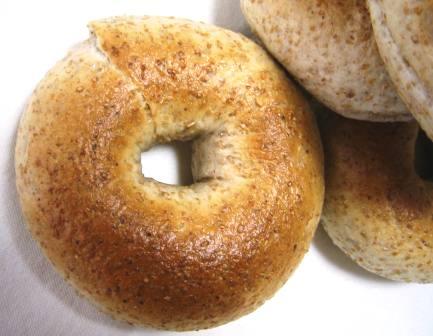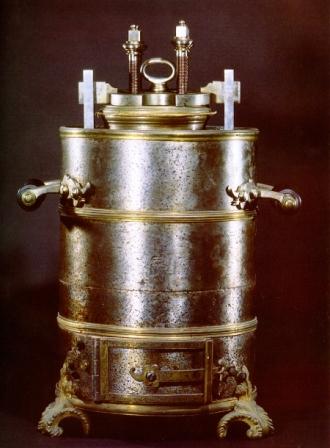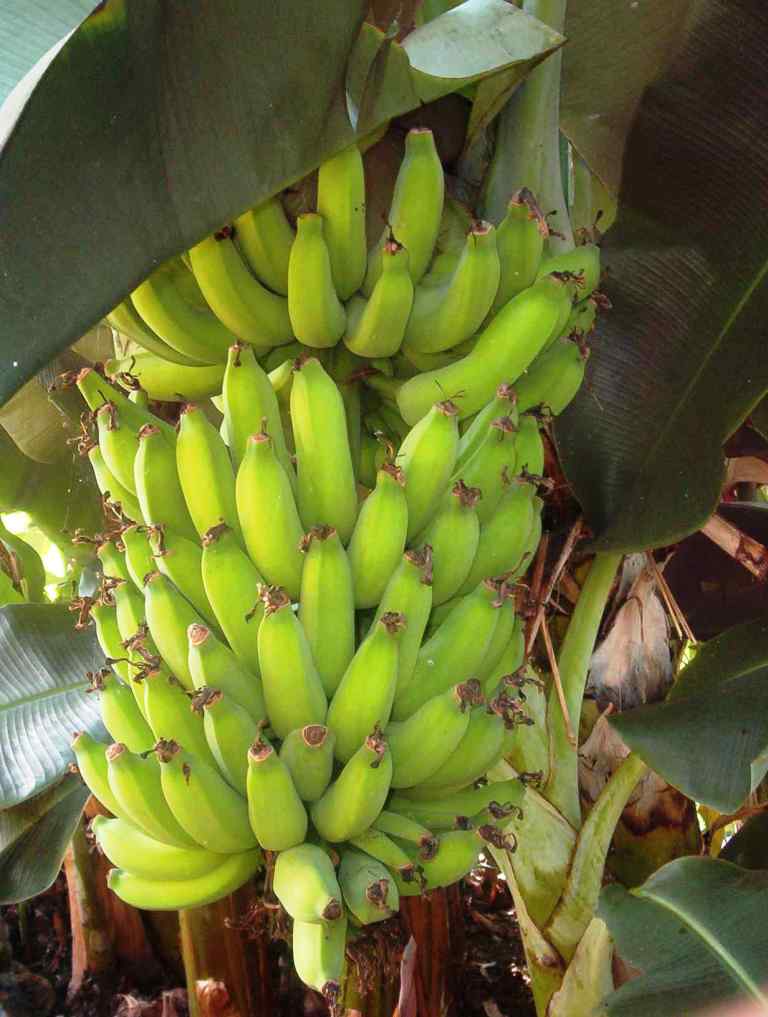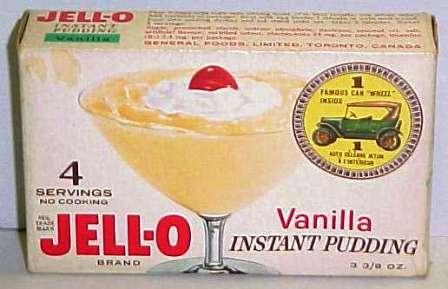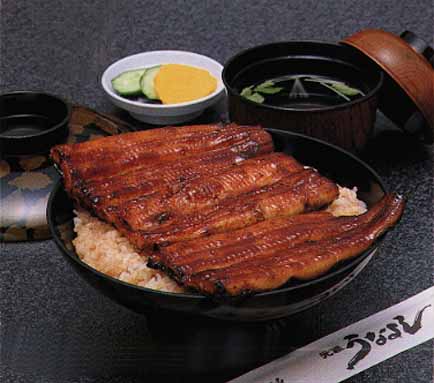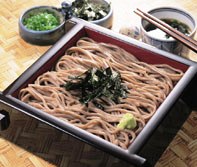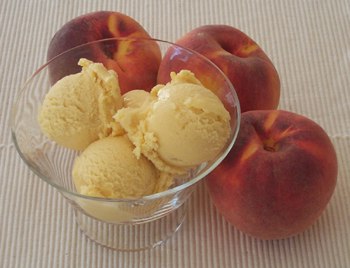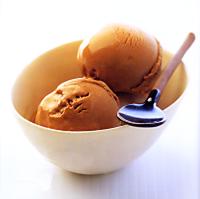· 1863
Granula, probablly the first breakfast cereal is introduced. It was
created by Dr. James C. Jackson of Dansville, N.Y.
·
1871
Thomas Adams patented a chewing gum producing machine. He manufactured
the first commercially successful chewing gum, 'Black Jack.'

·
1872
Walter Scott of Providence, Rhode Island invents the horse drawn lunch
wagon.
·
1872
Henry Tate, an English sugar merchant, patented a method of cutting
sugar into small cubes in 1872. He made a fortune.
·
1872 'Grand dictionnaire de la cuisine' was
published.
·
1873
Adolphus Busch developed a method of pasteurizing beer so it could
withstand temperature fluctuations, which enabled national distribution.
·
1876
The 'spreading chestnut tree' from 'The Village Blacksmith'
by Henry Wadsworth Longfellow, was a real tree in Cambridge,
Massachusetts, at the corner of Brattle and Story Streets. It was cut
down to widen the streets in 1876.
·
1879
James J. Ritty, of Dayton, Ohio, invented the cash register.
·
1880
E.W. 'Billy Ingram was born. Ingram was cofounder, with Walter A.
Anderson, of the White Castle hamburger chain.
·
1880
The wholesale price of Lobster was 10 cents per pound.
·
1881
Dr. Satori Kato of Japan introduced the first instant coffee at the Pan
American World Fair.
·
1882
Swiss flour manufacturer Julius Maggi begins commercial production of
the first bouillon cubes. He developed them so the poor had a cheap
method for making nutritious soup.
·
1884
W. Johnson patented an egg beater.
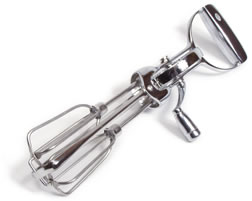
·
1885
Philadelphia brand cream cheese went on sale.
·
1885
Dr Pepper was invented in Waco, Texas. there is no period after the Dr
in Dr Pepper.
· 1887
Asa Candler (1851-1929) a wholesale drugist, purchased the formula for
Coca-Cola from John S. Pemberton an Atlanta pharmacist for $ 2,300. He
sold the company in 1919 for $25 million.
·
1888
The first chewing gum to be sold in vending machines was made by Thomas
Adams. He sold his gum in vending machines on elevated train station
platforms in New York.
·
1889
Aunt Jemima Pancake mix was introduced. It was the first ready-mix food
to be sold commercially.
·
1890
Peanut butter was developed by a St. Louis doctor for his patients with
bad teeth.
·
1891
Many food historians consider the first cafeteria to have been in the
YWCA of Kansas City, Mo. in 1891. It provided cheap, self-service meals
to working women.
·
1891
Fig Newtons were created by Kennedy Biscuit Works in Cambridgeport,
Massachusetts
·
1893
Juicy fruit chewing gum introduced.
· 1893
At the 1893 Chicago Fair, Pabst beer won a blue ribbon, and was called
'Pabst Blue Ribbon" beer from then on.
·
1895
In 1845, Peter Cooper, inventor and founder of the Cooper Union for the
Advancement of Science and Art, obtained the first American patent for
the manufacture of gelatin. In 1895, cough syrup manufacturer Pearl B.
Wait purchased the patent and developed a packaged gelatin dessert.
Wait's wife, May David Wait named it "Jell-O."
·
1895
Postum cereal beverage introduced by Postum Cereal Co.
· 1895
Rudolph Boysen was born. He developed the boysenberry, a
raspberry-blackberry hybrid in 1923.
·
1895
Gennaro Lombardi opened the first pizzeria in the U.S. in New York City.
·
1895
Cordon Bleu school of cooking was founded in Paris by Marthe Distell to
teach cooking to upper class women.

·
1896
Tootsie Rolls were introduced by Leo Hirshfield of New York who named
them after his daughter's nickname, 'Tootsie'.
·
1897
Campbell's Soup invents condensed soup.
· 1898
Caleb D. Bradham, a New Bern, North Carolina pharmacist created
Pepsi-Cola, in imitation of Coca-Cola. (He originally called it Brad’s
Drink).
·
1900
Campbell's Soup won a gold medal for their condensed soups at the Paris
Exposition of 1900.
·
1900
Chiclets chewing gum, with a hard sugar coating, was introduced.
·
1900
Dos Equis (XX) Mexican Beer was first brewed in 1900 and was originally
named 'Siglo XX' to signify the new millennium. Now it is simply called
Dos Equis 'XX'.
·
1900
Hershey's Milk Chocolate Bar was created.
· 1900
Ferdinand Carre died. In 1859 he invented the ammonia vapor compression
system for refrigeration. Vapour compression is still the system most
widely used today.
·
1902
National Biscuit Company changed the name of their Animal Biscuits to
'Barnum's Animals', and redesigned the package as a circus wagon with a
string attached so it could be hung on Christmas trees. They sold for 5
cents.
·
1902
The Clementine was developed in Algeria by Father Clement Rodier, a
French missionary. It is a hybrid of the tangerine and the Seville
orange (bitter orange).
·
1902
The pastel-colored candy disks called NECCO wafers first appeared, named
for the New England Confectionery Company.
·
1903
First U.S. patent for instant coffee.
·
1903
Richard Hellmann, a New York deli owner created his recipe for bottled
mayonnaise. He began to market it in 1912.
·
1903
Horace Fletcher published The ABC of Nutrition. In it he said that each
mouthful of food should be chewed 32 times. He had no medical or
scientific background.
· 1904
George J. French introduced French's mustard, the same year the hot dog
was introduced to America at the St. Louis World's Fair.

·
1904
The tea bag was invented by Thomas Sullivan of New York City. He first
used them to send samples to his customers instead of sending it in more
expensive tins.
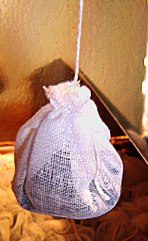
· 1904
Puffed Rice was introduced at the St. Louis World's Fair. Developed by
Dr. Alexander P. Anderson of NYC, and first manufactured by American
Cereal Co (which later became Quaker Oats Co.)
·
1904
Post Toasties were introduced by General Foods (originally called
‘Elijah's Manna.’)
·
1904
R. Blechyden served tea with ice at the St. Louis World's Fair and
invented iced tea.
·
1904
The ice cream cone was invented at the St. Louis World's Fair in 1904.
An ice cream vendor ran out of paper cups and asked a nearby waffle
booth to make some thin waffles he could roll up to hold the ice cream.
·
1905
G. Lombardi's an Italian restaurant on Spring Street in New York City,
served America’s first pizza.
·
1905
Popsicles were invented by Frank Epperson in 1905, they were originally
called Epsicles!
·
1905
Thomas Adams Died. He manufactured the first commercially successful
chewing gum, 'Black Jack.'
·
1906
Bel Paese cheese was created. Egidio Galbani created this popular
Italian cow's milk cheese. Its name means 'beautiful country,' and
supposedly comes from a book written by Father Antonio Stoppani, a
friend of the family.
·
1906
The Hot Fudge Sundae was created at C.C. Browns, an ice cream parlor on
Hollywood Boulevard in Los Angeles.
·
1906
The term 'filet mignon' is first used by O. Henry in his book
'The Four Million'
·
1907
Maytag washing machines are introduced. They were an addition to the
farm implements the company produce in Newton, Iowa. They were produced
during the seasonal slumps in farm implement sales.
·
1907
Gastronomie pratique (Practical Gastronomy) was published by
Henri Babinsky (nicknamed Ali-Bab).
·
1907
One of the ad campaigns for Kellogg's Corn Flakes (then the Battle Creek
Toasted Corn Flake Company) offered a free box of cereal to every woman
who would wink at her grocer.
·
1907
Scott Paper Co. introduced the first paper towel.
·
1908
Tom Carvel was born. He was the inventor of the soft-serve ice cream
machine, and founder of the ice cream chain, Carvel’s
·
1910
Cellophane was invented by Jacques Brandenberger, a Swiss chemist
·
1910
Ward Baking Company of Chicago, Illinois, opened the first automatic
bread factory. The bread, from start to finish, was untouched by human
hands, until it was placed in the wrapping machine.
·
1912
Richard Hellmann, a New York deli owner created his recipe for bottled
mayonnaise in 1903. He began to market it in 1912.
·
1914
The J.L. Kraft Bros. cheese factory was founded by James L. Kraft in
Stockton, Illinois.
·
1915
John Van Wormer invented the waxed cardboard milk carton. It took him 10
years to perfect the machinery to make them.
·
1916
Electric refrigerators were first offered for sale, for $900.
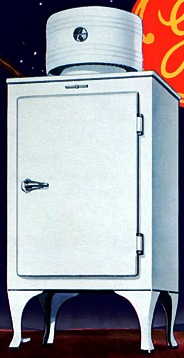
·
1916
Nathan Handwerker opened Nathan's in Coney Island, where he sold hot
dogs for a nickel.
·
1920s
Caesar Salad was created by Caesar Cardini in Tijuana.
·
1920
Fortune cookies were supposedly invented in Los Angeles.
·
1921
Harry MacElhone of Harry's Bar in Paris created the Bloody Mary
·
1921
Wheaties breakfast cereal was created.
·
1923
Candy maker Frank C. Mars of Minnesota introduced the Milky Way candy
bar in 1923.
·
1925
Roquefort cheese became the first cheese to receive the "Appellation
d'Origine Controlee" (AOC)
·
1926
Hormel Company of Austin, Minnesota marketed the first canned ham
·
1927
Dr.Edward Anton Asselbergs was born. He developed the process for making
instant mashed potato flakes, still used today.
·
1927
Pez peppermint breath mints were introduced in Vienna.
·
1928
Bubble gum invented by Walter E. Diemer of the Fleer Chewing Gum
Company.
·
1929
7-Up was originally called Bib-Label Lithiated Lemon-Lime Soda when it
was invented in 1929.
·
1933
Kit Kat candy bar invented.
·
1933
A California packer was able to homogenize peanuts into a stable butter
- 'Skippy Churned Peanut Butter'.
·
1933
Kraft Miracle Whip Salad Dressing is introduced by National Dairy
Products.
·
1934
It is claimed that cheeseburgers were first served in 1934 at Kaelin's
restaurant in Louisville, Kentucky.
·
1935
The American Can Co. introduced an enameled can for packaging beer. It
was an immediate success.
·
1936
Louis Ballast of Denver, Colorado was given a trademark for the name
'cheeseburger' in 1936. He never enforced it though.
·
1937
Kraft Macaroni & Cheese was introduced. Make a meal in 9 minutes or less
for 19 cents or less.
·
1938
Nestle's Crunch candy bar invented.
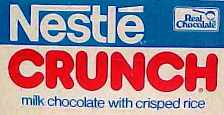
·
1939
The seedless watermelon was developed.
·
1940
The first Dairy Queen opened in Joliet, Illinois.
·
1940
M&M's candy invented.
·
1941
Garbage disposals introduced.
·
1942
Corn dogs are invented by Neil Fletcher for the Texas State Fair.
·
1943
Dr. Alexander P. Anderson Died. He developed Puffed Rice in NYC in 1902,
which was introduced to the world at the St. Louis World's Fair in 1904.
·
1944
Chiquita Banana, the song and the advertising jingle were both created
for United Fruit Company.
·
1946
Tupperware was introduced.
·
1950
The first credit card, the Diners Club was created by Frank McNamara
after he realized he had forgotten his wallet after dining at a
restaurant.
·
1950
There were 407 breweries in operation in the U.S.
·
1950
Sugar pops are introduced
·
1951
Swanson introduces beef, chicken, turkey pot pies.
·
1951
In a survey conducted of the U.S. armed services, banana cream pie was
the favorite dessert.
· 1952
The first sugar free no calorie soft drinks are introduced.
·
1952
Lipton's dry Onion Soup Mix is introduced.
· 1952
Sugar Frosted Flakes, 29 percent sugar, are introduced by Kelloggs.
·
1952
Clarence Birdseye introduces the first frozen peas.
·
1952
Mrs. Paul's introduces frozen fish sticks.
·
1952
Howard Johnson's becomes the world’s largest food chain when it opens
its 351st restaurant.
·
1953
White Rose Redi-tea is the world's first instant iced tea.
·
1953
Irish Coffee is supposedly created by a bartender Joe Sheridan at
Shannon Airport.
·
1953
Sugar Smacks are introduced - they contained 56% sugar.
·
1954
Kraft introduced Cracker Barrel brand natural cheese.
·
1954
Butterball self-basting turkeys are introduced.
·
1954
M&M's Peanut Chocolate Candies were introduced. Also, the the famous
slogan, 'The milk chocolate melts in your mouth, not in your hand,'
slogan is introduced.
·
1954
Schlitz, The Beer That Made Milwaukee Famous! introduced the 16 oz beer
can.
·
1954
Burger King was founded by James McLamore and David Edgerton.
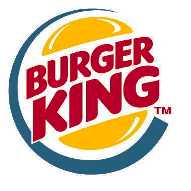
·
1955
Campbell’s developed the Green Bean Casserole Bake recipe.
·
1955
Frozen, fully stuffed turkeys, ready to cook, were introduced
·
1955
Kellogg introduced Special K breakfast cereal, with only 4.5% sugar.
·
1956
80% of U.S. households have a refrigerator, but only 8% of British
households do.
·
1956
Budweiser Brewery introduces Busch beer.
·
1956
First reference in print to the drink Bloody Mary appeared in 'Punch'
·
1957
Margarine sales exceed butter sales for the first time.
·
1957
General Foods Corp. introduces TANG breakfast beverage crystals.
·
1957
Dairy Queen Hamburgers and Hot Dogs are first added to the Dairy Queen
menu at some outlets in Georgia.
·
1958
Friskees introduced the first dry cat food
·
1958
Rice-A-Roni goes on sale. Produced by Vince DeDomenico from an Armenian
family recipe.
·
1958
Sweet n' Low was introduced as an artificial sweetener (granulated
saccharin, dextrose, cream of tartar and calcium silicate). It received
U.S. trademark patent no. 1,000,000.
·
1958
Frank Carney, 18 years old, reads about the pizza fad with college
students. He borrows $600 from his mother and opens the first Pizza Hut
in Wichita, Kansas.
·
1958
McDonald's sold its 100 millionth hamburger.
·
1959
Oklahoma repeals its 51 year old Prohibition law leaving Mississippi the
only 'dry' state in America.
·
1959
There are 32,000 supermarkets in the U.S. and account for 69 percent of
all food store sales.
·
1959
The aluminum beer can is introduced by Coors of Golden, Colorado.
·
1959
McDonald's opens its 100th restaurant in Fond Du Lac, Wisconsin.
·
1960
Dr. Asselbergs developed the process for making instant mashed potato
flakes, the basic process that is still used today.
·
1961
Carpaccio was invented in 1961 at Harry's Bar in Venice, Italy. It was
named for the Renaissance painter Vittore Carpaccio who was noted for
his use of red in his paintings. Thin sliced raw beef served with a cold
vinaigrette made with olive oil, or just olive oil and lemon juice (and
sometimes Parmesan cheese). Generally served on a bed of greens such as
watercresss, endive, arugula and/or radicchio. Originally the beef was
seared quickly, and the seared portion then trimmed off before slicing.
·
1962
The pull tab for beverage cans is introduced.
·
1962
Powdered butter was developed in Australia.
·
1963
Fruit Loops breakfast cereal is introduced.
·
1963
Irradiation was used for the first time to sterilize dried fruits and
vegetables.
·
1963
The one billionth McDonald's hamburger was served by Ray Kroc on the Art
Linkletter Show.
·
1964
The first 12 oz aluminum can was introduced by Royal Crown Cola. It
wasn't until 3 years later that Coke started using the aluminum can.
· 1965
Cool Whip, a whipped cream substitute, was introduced by General Foods.
·
1967
Gatorade, the original sports drink, is developed by the University of
Florida for their football team.
·
1967
Plastic milk bottles are introduced.
·
1967
Wisconsin was the last state to allow coloring to be added to margarine.
·
1968
The Big Mac was introduced at McDonalds for 49 cents.
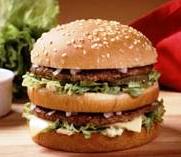
·
1969
Pringles potato chips were introduced - made from dehydrated, mashed
potatoes.
·
1970
Hamburger Helper was introduced
·
1971
The Quarter Pounder was introduced at McDonald's for 53 cents.
·
1971
The home food processor, Le Magi-Mix, was introduced in Paris by Pierre
Verdon, also the inventor of the restaurant version, Robot-Coupe.
·
1972
Andy MacElhone creates the Blue Lagoon cocktail. He is the son of Harry
of Harry's Bar in Paris.
·
1972
Hyman Golden and Leonard Marsh introduce Snapple Fruit Juices in New
York.
·
1973
American Carl Sontheimer refined the French made Robot-Coupe and came up
with the Cuisinart.
·
1973
Nathaniel Weyth received patent for PET (polyethylene terephthalate)
beverage bottles. This was the first safe plastic strong enough to hold
carbonated beverages without bursting.
·
1974
The stay-on tab for beverage cans was invented.
·
1974
Pop Rocks were unveiled by General Foods. Ever since 1956, when company
research chemist William Mitchell found a way to put carbon dioxide into
a solid, General Foods searched for a way to market the invention. The
popping, crackling candy turns out to be worth the wait; in only five
years the company will have sold 500 million packets of Pop Rocks.
·
1976
There are no red M&Ms from 1976 to 1987
·
1978
Ben & Jerry’s Homemade Ice Cream and Crepes opens.
·
1979
Paul Prudhomme opened K-Paul's Louisiana Kitchen.
·
1981
Lean Cuisine frozen dinners were introduced.
·
1981
The artificial sweetener aspartame was approved by the FDA
·
1981
The Yukon Gold potato was introduced.
·
1981
Jell-O Gelatin Pops were introduced
·
1981
Radicchio (a red variety of chicory) was first grown commercially in
this country in 1981 in California.
·
1982
Newman's Own Food is founded by Paul Newman and he devotes the profits
to charity.
·
1982
Wolfgang Puck opens Spago.
·
1984
Sugar Free Jell-O is introduced.
·
1984
McDonald's served its 50 billionth hamburger.
·
1985
Coca Cola introduces its new formula - no one wants it.
·
1986
Pop Secret Microwave Popcorn in introduced by General Mills
·
1987
Red M&Ms return. There were none since 1976.
·
1987
Snapple Iced Tea drinks are introduced.
·
1987
The alligator was designated the official state reptile of Florida in
1987
·
1987
North Carolina adopted milk as the official state beverage.
·
1990
Cook's Magazine folds.
·
1990
Eating Well magazine begins publication.
·
1991
Salsa sales overtakes ketchup sales for the first time ($sales)
·
1992
Electric bread machines are introduced.
·
1993
SnackWell's reduced-fat cookies are introduced.
·
1993
The Food Network premiers on television.
·
1995
Betty Crocker gets her own website.
·
1995
Blue M&Ms are introduced.
·
1996
Olestra fat substitute is approved.
·
1998
In West Virginia if you run over a animal, you can legally take it home
and cook it for dinner. A law passed in 1998 lets drivers keep their
road kill, as long as they report it within 12 hours. According to
supporters of the new law, the state will the save money that had been
used to have Highway Division employees remove dead animals from the
road.

